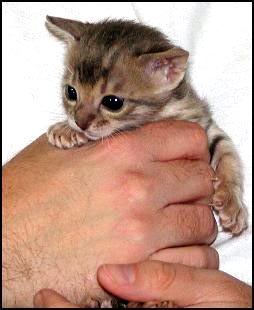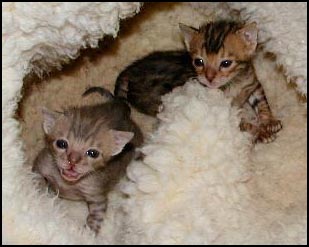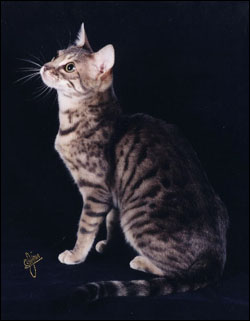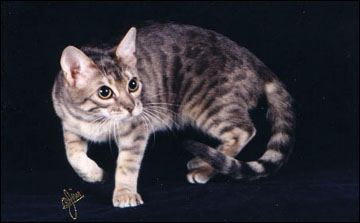
Foothill Felines Moodie Blue, Lovely Spotted Blue Female Bengal at 7 months old

|
What is a BLUE Bengal? The color gene responsible for producing a "blue" Bengal cat is known as a recessive gene; that is, it may be carried by any color and pattern type of Bengal Cat, without the blue gene necessarily showing up in the cat. When a blue male Bengal is bred to a blue female Bengal, all the resulting kittens will be blues. However, it is quite possible for two non-blue Bengals to mate and, if both recessively carry this color gene, produce some blue kittens in their resulting litter, or in future generations if the gene continues to be recessively carried by the offspring. Below, some pictures of Foothill Felines Moodie Blue at just a few weeks old. Compare her color to that of her brown spotted Bengal sister, Foothill Felines Mistletoes!



At this time, the blue Bengal is not a recognized color within the major cat associations here in the United States; however, blues are able to be shown in the NBC (New Breed Color) divisions, and also for regular championship status in Canada. Interestingly, breeders who have had quite a bit of experience with the blue Bengals have found that when dealing with a recessive gene such as the blue color gene, often other recessive genes come in to play in the same kitten, such as desirable large spots in the spotted pattern, the "glitter" gene, which also produces some of the softest and most pelted coats in the Bengal cat. This is one reason why in some areas, blue Bengals are gaining rapidly in popularity, and some breeders are choosing to work specifically with the blue Bengals to try to get this color recognized within the official Bengal breed standard in its own color class and division. Below, a look at Foothill Felines Moodie Blue at 1 year old.




There is quite a bit of controversy within the Bengal community as to the breeding value of the blue Bengals. Many long time Bengal breeders know that when working with a recessive color gene such as the blue gene, once it is incorporated in a breeding program, it is a difficult and lengthy process (sometimes almost impossible) to then try to eliminate the gene from showing up in future generations. As young kittens, blue Bengals will most often have a color best described as "battleship grey", especially in the tail tips and markings on the foreheads. Blue Bengals will have gold to green eyes as adults, with the gold eyes seemingly more dominant in the blue Bengals than the green eyes. Blue Bengals can also show a soft peach undercoat, and often have a special softness and elegance to them creating their own unique style. The way the blue color gene works (and "blue" is considered a dilute color form of the traditional "brown" tabby color), there can be blue spotted and marbled Bengals; blue lynxpoint spotted and marbled Bengals; blue mink spotted and marbled Bengals, blue sepia spotted and marbled Bengals, etc. (Foothill Felines wishes to thank Gene Ducote of Gogees and the Lifetime Bengal Breed Advisor for The International Bengal Cat Society for her valuable contributions regarding the history and genetics of the blue Bengal.)
|
© 1996-2008 Copyright
by HDW Enterprises, Inc. - All Rights Reserved. 
HDW Enterprises,
Inc., P.O. Box 418104, Sacramento, CA 95841-8104 (916) 481-CATS ph/fax
http://www.hdw-inc.com e-mail: holly@hdw-inc.com